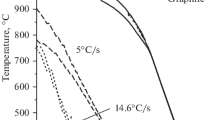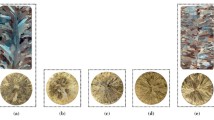Abstract
Antifriction tin bronzes and, in particular, C92900 bronze are used in mechanical engineering to manufacture parts subject to friction. Permanent mold casting into steel molds is commonly used to produce parts from C92900 bronze. The feasibility of producing C92900 bronze rods by hot extrusion and upward casting methods is explored. The hot extrusion temperature and ram speed, as well as the upward casting speed at which defects do not emerge in rods is determined. Hot extrusion is shown to result in a significant refinement of grains down to 1.7 μm, while upward casting, on the contrary, results in an increase in the grain size in comparison with permanent mold casting. Regarding microstructure, γ-Cu3Sn intermetallic phase crystals are refined in hot extrusion and continuous upward casting. Large agglomerations of Pb particles can be observed in the extruded bronze microstructure, which presumably lead to a decrease in the coefficient of friction. Maximum hardness and tensile strength are characteristic of the rods produced by hot extrusion at 600°C, while the highest elongation at fracture is obtained in the rods produced by upward casting. Tribological studies conducted using the “shaft–partial insert” setup in a kerosene medium with a steel counter body show that hot extrusion leads to a tenfold increase in wear resistance and a threefold decrease in the coefficient of friction in comparison with the rods obtained by permanent mold casting. The rods obtained by the upward casting method, on the contrary, exhibit a decrease in wear resistance. Given these results, hot extrusion may be recommended along with the casting technique for manufacturing bronze C92900 rods.









Similar content being viewed by others
REFERENCES
Gruzdeva, I.A., Sulitsyn, A.V., Mysik, R.K., and Sokunov, B.A., Influence of electromagnetic stirring on the microstructure and properties of tin bronze, Liteishchik Ross., 2006, no. 11, pp. 27–29.
Song, K., Zhou, Y., Zhao, P., Zhang, Y., and Bai, N., Cu-10Sn-4Ni-3Pb alloy prepared by crystallization under pressure: An experimental study, Acta Metall. Sin. (Engl. Lett.), 2013, vol. 26, pp. 199–205.
Belov, V.D., Gerasimenko, E.A., Guseva, V.V., and Konovalov, A.N., Influence of BrO10S2N3 tin bronze solidification conditions on its microstructure, Liteinoe Proizvod., 2016, no. 2, pp. 26–33.
Ozerdem, M.S. and Kolukisa, S., Artificial neural network approach to predict the mechanical properties of Cu–Sn–Pb–Zn–Ni cast alloys, Mater. Des., 2009, vol. 30, pp. 764–769.
Vershinin, P.I., Sevast’yanov, V.I., and Bakrin, Yu.N., Influence of cooling intensification on microstructure and properties of tin bronze castings, Liteinoe Proizvod., 1986, no. 5, pp. 8–9.
Semenov, K.G., Koloskov, V.F., and Chursin, V.M., Development of quality castings production technology using tin bronze pigs, Liteinoe Proizvod., 1994, no. 7, pp. 10–12.
Brontvain, L.R. and Gorodetskii, V.N., Soundness of casting copper alloys, Liteinoe Proizvod., 1985, no. 10, pp. 14–16.
Bakhtiarov, R.A., Vorob’eva, L.A., Pokrovskaya, G.N., and Kraeva, T.M., Influence of temperature and casting speed on the structure and properties of copper-based alloy ingots, Tsvetn. Met. (Moscow, Russ. Fed.), 1974, no. 1, pp. 68–71.
Ludwig, A., Gruber-Pretzler, M., Wu, M., Kuhn, A., and Riedle, J., About the formation of macrosegregations during continuous casting of Sn-Bronze, Fluid Dyn. Mater. Process., 2005, vol. 1, pp. 285–300.
Sergejevs, A., Kromanis, A., Ozolins, J., and Gerins, E., Influence of casting velocity on mechanical properties and macro-structure of tin bronzes, Key Eng. Mater., 2016, vol. 674, pp. 81–87.
Korchmit, A.V. and Egorov, Yu.P., Influence of pouring temperature on the distribution of lead inclusions in multicomponent lead-tin bronze, Izv. Tomsk. Politekh. Univ., 2004, vol. 307, no. 6, pp. 105–108.
Nyyssönen, T., Leaded tin bronzes: the effects of casting method on dry sliding behavior, Tribol.: Finn. J. Tribol., 2012, vol. 31, pp. 4–11.
Ruusila, V., Nyyssönen, T., Kallio, M., Vuorinen, P., Lehtovaara, A., Valtonen, K., and Kuokkala, V.-T., The effect of microstructure and lead content on the tribological properties of bearing alloys, Proc. Inst. Mech. Eng., Part J, 2013, vol. 227, pp. 878–887.
Sadawy, M.M. and Ghanem, M., Grain refinement of bronze alloy by equal-channel angular pressing (ECAP) and its effect on corrosion behaviour, Def. Technol., 2016, vol. 12, pp. 316–323.
Popov, V.V., Stolbovskii, A.V., Popova, E.N., Falakhutdinov, R.M., and Shorokhov, E.V., Evolution of the structure of tin bronze under dynamic channel-angular pressing, Phys. Met. Metallogr., 2017, vol. 118, pp. 864–871.
Gupta, R., Srivastava, S., Kumar, N.K., and Panthi, S.K., High leaded tin bronze processing during multi-directional forging: Effect on microstructure and mechanical properties, Mater. Sci. Eng., A, 2016, vol. 654, pp. 282–291.
Hui, J., Feng, Z., Wang, P., Fan, W., and Liu, Z., Microstructural evolution analysis of grains and tensile properties of tin bronze in hot extrusion at different temperatures, Mater. High Temp., 2019, vol. 36, pp. 68–75.
Krivtsova, O., Ibaov, M., Tolkushkin, A., Talmazan, V., and Amanzholov, Z., Investigation of ECAP on microstructure and mechanical properties of bronze at different temperatures, J. Civil Eng. Constr., 2016, vol. 5, pp. 83–89.
Gupta, R., Srivastava, S., Kumar, G.V.P., and Panthi, S.K., Investigation of mechanical properties, microstructure and wear rate of high leaded tin bronze after multidirectional forging, Procedia Mater. Sci., 2014, vol. 5, pp. 1081–1089.
Gupta, R., Panthi, S.K., and Srivastava, S., Study of microstructure, mechanical properties and wear rate of high leaded tin bronze after multidirectional forging, Mater. Today: Proc., 2015, vol. 2, pp. 1136–1142.
Gadallah, E.A., Ghanem, M.A., El-Hamid, M.A., and El-Nikhaily, A.E., Effect of tin content and ECAP passes on the mechanical properties of Cu/Sn alloys, Am. J. Sci. Technol., 2014, vol. 1, pp. 60–68.
Gadallah, E.A., Ghanem, M.A., El-Hamid, M.A., and El-Nikhaily, A.E., Effect of tin content and ECAP passes on the mechanical properties of Cu/Sn alloys as bearing materials, Port-Said Eng. Res. J., 2014, vol. 18, pp. 79–89.
Empl, D., Laporte, V., Vincent, E., Dewobroto, N., and Mortensen, A., Improvement of elevated temperature mechanical properties of Cu–Ni–Sn–Pb alloys, Mater. Sci. Eng., A, 2010, vol. 527, pp. 4326–4333.
Nejadseyfi, O., Shokuhfar, A., and Moodi, V., Segmentation of copper alloys processed by equal-channel angular pressing, Trans. Nonferrous Met. Soc. China, 2015, vol. 25, pp. 2571–2580.
Yan, P., Wang, D., Yan, B., and Mo, F., Effect of size refinement and distribution of the lubricating lead phases in the spray forming high-leaded tin bronze on wear rates, Mod. Phys. Lett. B, 2013, vol. 27, p. 1341019.
Sheppard, T. and Greasley, A., Structure and properties of some tin bronzes produced by extrusion of atomized powders, Powder Metall., 1978, vol. 21, pp. 155–162.
Hwang, J.D., Li, B.J., Hwang, W.S., and Hu, C.T., Comparison of phosphor bronze metal sheet produced by twin roll casting and horizontal continuous casting, J. Mater. Eng. Perform., 1998, vol. 7, pp. 495–503.
Tavolzhanskii, S.A. and Koletvinov, K.F., Development and application of method of continuous upward casting of billets of small assortment high-temperature solders, Tsvetn. Metall. (Moscow, Russ. Fed.), 2015, no. 11, pp. 85–89.
Koletvinov, K.F., Tavolzhanskii, S.A., and Bazhenov, V.E., Research and development of copper alloys billets continuous-discrete upcast process, Sbornik trudov Vserossiiskoi nauchno-prakticheskoi konferentsii “Sostoyanie i perspektivy razvitiya liteinykh tekhnologii i oborudovaniya v tsifrovuyu epokhu” (Proc. All-Russian Scientific and Practical Conference “State and Prospects for the Development of Foundry Technologies and Equipment in the Digital Age”), Moscow: Moscow State Univ. of Mechanical Engineering “MAMI”, 2016.
Zheng, X., Cahill, D., Krasnochtchekov, P., Averback, R., and Zhao, J., High-throughput thermal conductivity measurements of nickel solid solutions and the applicability of the Wiedemann-Franz law, Acta Mater., 2007, vol. 55, pp. 5177–5185.
Bazhenov, V.E., Titov, A.Yu., Shkalei, I.V., Sannikov, A.V., Nikitina, A.A., Plisetskaya, I.V., Bazlov, A.I., Mezrin, A.M., and Koltygin, A.V., Effect of cooling rate on C92900 bronze microstructure and properties, Russ. J. Non-Ferrous Met., 2021, vol. 62, no. 3, pp. 274–285.
Harkki, K. and Miettinen, J., Mathematical modeling of copper and brass upcasting, Metall. Mater. Trans. B, 1999, vol. 30, pp. 75–98.
Brontvain, L.R. and Gorovetskii, V.N., Study of wear resistance of copper-based alloys, Liteinoe Proizvod., 1981, no. 10, pp. 8–9.
Image Processing and Analysis in Java. https://imagej.nih.gov/ij/docs/menus/analyze.html. Accessed September 1, 2020.
Alpas, A.T. and Zhang, J., Effect of microstructure (particulate size and volume fraction) and counterface material on the sliding wear resistance of particulate-reinforced aluminum matrix composites, Metall. Mater. Trans. A, 1994, vol. 25, pp. 969–983.
Andrusenko, O.E. and Matveev, Yu.I., Requirement for the materials of the anti-friction layer used at the restoration of plain bearings of crankshafts, Vestn. Astrakh. Gos. Tekh. Univ. Ser.: Morsk. Tekh. Tekhnol., 2009, no. 1, pp. 50–55.
Funding
This research received financial support from the Ministry of Science and Higher Education in the Russian Federation (Agreement no. 075-11-2019-045 from November 22, 2019) under the program “Scientific and technological Development of the Russian Federation” as per governmental decree no. 218 dated April 9, 2010.
Author information
Authors and Affiliations
Corresponding authors
Ethics declarations
The authors declare that there is no conflict of interest.
Additional information
Translated by M. Shmatikov
About this article
Cite this article
Bazhenov, V.E., Titov, A.Y., Shkalei, I.V. et al. Study of the Properties of C92900 Bronze Obtained by Permanent Mold Casting, Upward Casting, and Hot Extrusion. Russ. J. Non-ferrous Metals 62, 413–423 (2021). https://doi.org/10.3103/S1067821221040040
Received:
Revised:
Accepted:
Published:
Issue Date:
DOI: https://doi.org/10.3103/S1067821221040040




